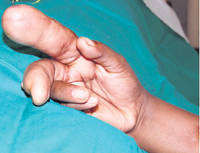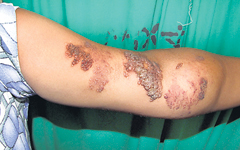
| You don’t have to live with those benign tumours Shehan was born with an angry-looking lump that dominated his face. Naturally anxious, his parents sought medical attention to discover that he had Haemangioma - a benign tumour-like condition formed by extra and abnormal growth of blood vessels. To control the growth of the tumour, steroid tablets were given from early infancy. At the age of five when the lump showed signs of regression, the residual mass was surgically excised leaving behind merely a small and inconspicuous scar.
Consultant Plastic and Reconstructive Surgeon, Dr. Dammika Dissanayake who performed the surgery explains that benign tumours are a large group of conditions found inside almost all organs inclusive of skin. "Virtually all tissues in the skin upto the underlying muscle can give rise to tumours: skin, the fat beneath, skin appendages such as sweat glands, sebaceous glands, tendons, nerves or blood vessels," he says. Tumours and tumour-like conditions can also occur on shinbones and the forehead, formed of that particular tissue and incorporated within the structure. Non-life threatening as its name implies, a benign tumour is an abnormal growth of tissue that can grow quite large without causing problems. Some of the slow-growing tumours are caused by genetic mishaps and can develop on any part of the body ranging from 1mm to 60 mm in size. Notably, such tumours do not invade neighbouring tissues or return after surgical removal. Normally, the lumps are surrounded by a fibrous capsule, which makes it easy to remove by surgery. In rare cases benign tumours can put pressure on surrounding tissues and organs leading to complications. This article is limited to those that are visible and palpable. Explaining the clinical features of benign tumours, Dr. Dissanayake clarifies that most are painless. "It is their appearance and growth that can cause anxiety." However, the location of the tumour can cause slight pain when pressed, especially if located on/near a nerve in which case certain clothes can also cause discomfort. Some of these tumours, which are rarely life-threatening, can bleed when injured.
Importantly, tumours need to be clinically diagnosed based on location and physical appearance. On rare occasions, an investigation involving MRI or Ultra Sound is required. Most benign tumours can be left alone unless they cause discomfort or concern. Change in colour, appearance, size, itchiness, pain and bleeding are warning signs for a patient to see a clinician and rule out the risk of tumours turning malignant. This applies mainly to skin lumps such as moles. Most lumps it appears can be removed 100% unless the location does not permit. Excision is done under general anaesthesia or local, if close to the skin and the method is determined by size, location, and numbers. Occasionally tumours can be deep seated and hence appear small to touch. "What is felt on the outside could simply be the tip of the iceberg," the surgeon says. Such large tumours could block passages, compress vessels, nerves and organs. Others could get infected, and could spread to other parts of the body. |
|| Front
Page | News | Editorial | Columns | Sports | Plus | Financial
Times | International | Mirror | TV
Times | Funday
Times | MediScene || |
| |
Copyright
2007 Wijeya
Newspapers Ltd.Colombo. Sri Lanka. |

